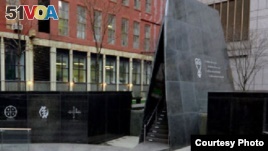August 06,2015
In New York City, on lower Manhattan Island, lie two and a half hectares of land that represent brutal early American history. It’s where many Africans who were slaves in homes, factories and the city’s burgeoning port are buried. They were among untold numbers of Africans forcibly taken from their homelands and brought to the New World in chains. For hundreds of years, they were simply forgotten.
That changed in 1991 when the bones of over 400 people were unearthed during construction of a federal office building. A portion of the burial ground was set aside as a monument to the slaves and the bones were re-interred during a ceremony in 2003. It’s now hallowed ground as the African Burial Ground National Monument.
On a quiet Lower Manhattan street, a stream of water symbolizing the Atlantic Ocean flows alongside a narrow boat-like structure – an echo of the ships as they made their way to the New World heavy laden with human cargo .

African Burial Ground National Monument in New York City. (Credit: National Park Service)
Nearby, Juanita Jones, an elderly African American fixes her gaze on grassy mounds. They are the main visible reminder of the vast 17th and 18th century Negro Burial Ground - now the African Burial Ground National Monument.
“Most of these were young people but they didn’t live to be so old. They died very young. You looking down here you see babies, newborns, and young people dying. It’s very bad,” said Jones.
Like Ms. Jones, Mary Palmer is an African American, born in Harlem further north in Manhattan. She has just emerged from within the slave ship structure.
“When I walked through I felt my heart starts jumping because I’m feeling the souls coming up to me. Like your cousin or somebody you never saw before comes up to you? And then they say ‘Oh hi.’ They touch you… you feel it. So that’s what it felt like. Somebody who was part of my family might have been they touched me inside and shook me a little bit. I had to lean back and hold on. It’s very heart-wrenching, kind of scary.”
Phillips: “You had such a strong reaction.”
Palmer: “Oh yes. Very much so.”
Michael Jiwa and his family are visiting New York from Nigeria. He has a sense that some of the people buried may be his ancestors, and feels his visit has offered him a bit of closure.
“It’s a good thing to come and see where your ancestors are buried. Even if you don’t see them alive, at least you know where they are buried. And that gives you a kind of joy at least. You always want to know where you came from, where you originated from. If you don’t know your origin, people see you as an outcast, like nobody,” he said.
Meanwhile, Billy Williams, of the Bronx, Manhattan’s neighboring borough to the north, stands by the mounds, shaking his head.
“I have never been much into genealogy but I do know that I have some African ancestry, and I wonder if I was just standing on a few. It’s horrific. It’s sad. To look at a piece of cement that says kids are buried underneath that is heart wrenching to anyone. It’s beyond my verbal description what I feel. I am going to make it a point to bring my grandchildren down here so they can see this important part of our history,” he said.
For Shirley Moultrie, the clean elegant feel of the monument misrepresents the actual history of African slavery in New York, when cruelty and misery were part of everyday life.
“It’s too modern,” she said, “They make it seem like ‘Everything is okay. They’re just buried here. They chained us, they beat us until we said ‘Massuh.’ [Master] Until we didn’t even know our name! We was almost like animals. Whatever they say do, we did. Because we was scared of the whip. We was taught sometime to hate ourselves. I think it’s very sad.”
Moultrie said for African Americans, the past continues in the present, both in the racist ways they are often treated, and in their own attitudes towards others.
“I think sometimes the blacks do have the hatred for others because of this. It’s the way the white man tells us something and we might say ‘yes sir,’ ‘no sir’ because we don’t know any better. Now I don’t feel it as much, but I am standoffish from them to a certain degree – whites, Caucasians, whatever you want to call them. But we have to get beyond that.”
As visitors to this place have learned, and as recent headlines have made clear, “getting beyond” the past can be a long, difficult and painful ordeal
The creators of the African Burial Mound Monument hope this site can a place to begin to discover, remember, and ultimately to heal that legacy.